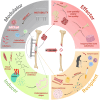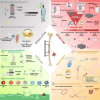Engineering the bone reconstruction surgery: the case of the masquelet-induced membrane technique
- PMID: 40102268
- PMCID: PMC11919993
- DOI: 10.1007/s00068-025-02815-9
Engineering the bone reconstruction surgery: the case of the masquelet-induced membrane technique
Abstract
The reconstruction of large bone defects remains challenging for orthopedic surgeons. Autologous bone grafts (ABGs) are the gold standard treatment for limited size defects, but larger bone defects (> 5 cm) require the use of more sophisticated techniques, such as the Masquelet technique. Over the last three decades, the Masquelet or induced membrane technique (IMT) has become increasingly popular as it does not require high-precision microsurgery skills and the time taken to achieve bone consolidation is independent of the length of the defect. IMT is a two-stage procedure. In the first stage, a polymethylmethacrylate (PMMA) cement spacer is implanted into the bone lesion and a physiological immune reaction initiates the formation of a fibrotic induced membrane (IM) with both angiogenic and osteogenic properties. The second stage, performed several weeks later, involves removal of the spacer followed by the implantation of a standard ABG in the preserved IM cavity for subsequent bone repair. In this extensive review, we explain how the success of this surgical procedure can be attributed to the synergy of four key components: the inducer (the PMMA cement), the recipient (the IM), the effector (the bone graft) and the modulator (the mechanical environment). Conversely, we then explain how each key component can contribute to the failure of such treatment. Finally, we discuss existing or emerging innovative and biotechnology-oriented strategies for optimizing surgical outcome with respect to the four components of IMT described above.
Keywords: Bone repair; Foreign body reaction; Induced membrane; Masquelet; Orthopedic surgery.
© 2025. The Author(s).
Conflict of interest statement
Declarations. Competing interests: The authors declare no competing interests.
Figures





Similar articles
-
The Masquelet Technique: Can Disposable Polypropylene Syringes be an Alternative to Standard PMMA Spacers? A Rat Bone Defect Model.Clin Orthop Relat Res. 2021 Dec 1;479(12):2737-2751. doi: 10.1097/CORR.0000000000001939. Clin Orthop Relat Res. 2021. PMID: 34406150 Free PMC article.
-
[Progress of Masquelet technique to repair bone defect].Zhongguo Xiu Fu Chong Jian Wai Ke Za Zhi. 2013 Oct;27(10):1273-6. Zhongguo Xiu Fu Chong Jian Wai Ke Za Zhi. 2013. PMID: 24397145 Review. Chinese.
-
Osteoclasts and their precursors are present in the induced-membrane during bone reconstruction using the Masquelet technique.J Tissue Eng Regen Med. 2017 Feb;11(2):382-389. doi: 10.1002/term.1921. Epub 2014 Jun 12. J Tissue Eng Regen Med. 2017. PMID: 24919776
-
Histological analysis of induced membranes in patients whose bone defects were treated with the Masquelet technique to identify factors affecting the vascularity of induced membranes.J Orthop Surg Res. 2021 Apr 13;16(1):248. doi: 10.1186/s13018-021-02404-7. J Orthop Surg Res. 2021. PMID: 33849590 Free PMC article.
-
[Biological reconstruction of large bone defects : Masquelet technique and new procedures].Unfallchirurgie (Heidelb). 2023 Mar;126(3):184-189. doi: 10.1007/s00113-022-01267-9. Epub 2022 Dec 27. Unfallchirurgie (Heidelb). 2023. PMID: 36573997 Review. German.
Cited by
-
An ingenious design from nature to accelerate the repair of long-bone critical defects: the longitudinal tubular transverse interconnection structure of deer antlers.Mater Today Bio. 2025 Jul 15;34:102090. doi: 10.1016/j.mtbio.2025.102090. eCollection 2025 Oct. Mater Today Bio. 2025. PMID: 40735702 Free PMC article.
References
-
- Greenwald AS, et al. Bone-graft substitutes: facts, fictions, and applications. J Bone Joint Surg Am 83-A Suppl 2 Pt. 2001;2:98–103. - PubMed
-
- Cuthbert RJ, et al. Induced periosteum a complex cellular scaffold for the treatment of large bone defects. Bone. 2013;57:484–92. - PubMed
-
- Klopfleisch R, Jung F. The pathology of the foreign body reaction against biomaterials. J Biomed Mater Res A. 2017;105:927–40. - PubMed
-
- Trindade R, Albrektsson T, Tengvall P, Wennerberg A. Foreign body reaction to biomaterials: on mechanisms for buildup and breakdown of osseointegration. Clin Implant Dent Relat Res. 2016;18:192–203. - PubMed
Publication types
MeSH terms
Substances
Grants and funding
LinkOut - more resources
Full Text Sources
Medical

